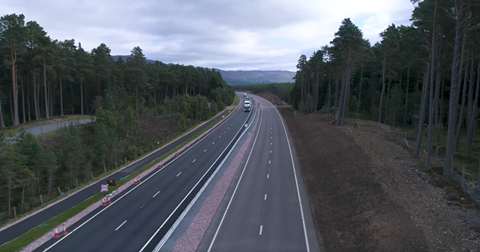
Better productivity and safety were the standout elements of a report published by the DfT assessing the impact of raising the speed limit for trucks over 7.5t GVW in England and Wales, writes Transport News editor Kevin Swallow.
On 6 April 2015 the speed limit on single carriageways was raised from 40mph to 50mph, and dual carriageways from 50mph to 60mph to match motorways. It has been a good news story for hauliers. It came six months after Transport Scotland had begun a trial on the A9 between Perth and Inverness raising the speed limit for HGVs above 7.5t to 50mph in October 2014 to help improve traffic flow.
Maintaining and governing the road infrastructure and laws is a devolved issue. The Scottish Government elected not to implement the changes made by the DfT for England and Wales until it had evaluated its own trials and sees a third-year report from the DfT published later this year before it considers any changes.
The ‘Evaluation of the National HGV Speed Limit Increase in England and Wales: year 2’ interim report published by the DfT in June 2019 says that increasing HGV speed limits saved businesses about £10m a year by saving more than 650,000 driving hours. The report alludes to the new speed limit also contributing to fewer HGV-related crashes, something the DfT said it will expand on with the third and final report.
It states: “There has been no statistically significant change in the number of accidents involving at least one HGV on dual carriageway roads. There is evidence of a statistically significant reduction in accidents across all study roads, although this finding is sensitive to the data series and will require confirmation from the Year 3 work.”
The trial on the A9 was something pushed for by the RHA. Martin Reid, policy director covering Scotland and Northern Ireland, says: “The RHA was instrumental in securing the 50mph speed trial on the A9 and it has long been our opinion that this increase would not only help productivity but road safety as well.
“By reducing the speed differential between cars and trucks, it would reduce the amount of accidents caused by driver frustration. Anyone using the A9 now will agree that it is a very different driver experience from what we had before the changes (HGV speed limit change and average speed camera’s) were made.”
A spokesperson for Transport Scotland told motortransport.co.uk: “The three-year analysis of this [A9 trial] was published in July 2018 and noted a reduction in overtaking related accidents and improved journey time reliability. The higher HGV speed limit remains in place and will continue as A9 dualling works progress.
“While there are currently no further plans to increase the HGV speed limits in Scotland, this will be re-examined when three years of evidence becomes available from England and Wales.
“The DfT’s three-year evaluation of the HGV speed increase will help develop our understanding of the impact of the HGV speed limit change on driver behaviour, vehicle speeds, the economy, the environment, and most importantly, road safety. When the impacts are known, later this year, we will assess the potential for an increase on roads in Scotland.”
No safety compromise
Reid agrees that road safety cannot be compromised. “At the start of the A9 speed trial we agreed that an evidence-based approach should be taken when looking at an emotive subject such as changing speed limits. Should the evidence show that productivity increases, and cost reduces without compromise on road safety, then the Scottish Government should ensure that a level playing field exists for all companies in the UK.”
In the meantime, hauliers using Scottish roads will have to stick to the lower limit. John Mackirdy, who runs John Mackirdy Haulage on the Isle of Bute, says with the aid of ABS and EBS on the modern truck there are fewer accidents and less frustrated drivers on the roads with increased speed limits. “If you drive the A66 in northern England or the A9 to Inverness this quite clearly bolsters the argument for the 50mph limit on A-roads, he says. “You could also argue that the limit should be increased on the A75 (across Dumfries and Galloway) and parts of the A82 (between Glasgow and Inverness). However, there are certainly stretches of that road where this increase would be inappropriate in my view.
“I would suggest a strategic approach, increasing speed limits to 50mph on certain roads while maintaining the limit at 40mph on other stretches. I think this approach would provide the benefits of increased productivity and reduced accident numbers.”
Stuart Black, MD of Blacks Haulage Solutions in Bathgate, says that the speed limit has got to change and feels the A9 trial has been pretty successful. “Raising the speed limit would save me fuel, time and reduce wear and tear on the trucks, it would have a big impact to the business,” he says. “However, I agree that certain single-carriageway roads, like sections on the west coast, would have to stay at 40mph because they are not so good but if its policed properly it would work very well.”
MD of John Mitchell Haulage and Warehousing in Grangemouth, Iain Mitchell, says the 40mph is a nuisance, which is more of a danger than travelling at 50mph.
“The benefits of traveling at 50mph would be less stress for the lorry driver, emissions would be reduced, and other drivers would not be stressed and take gambles to pass a slow-moving truck,” he argues.
He says based on the evidence from England and Wales it will be hard to argue against an increase.














